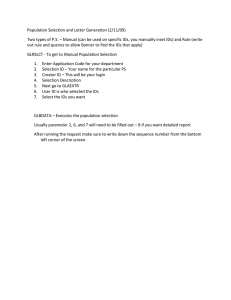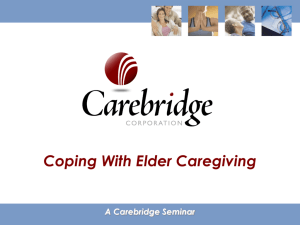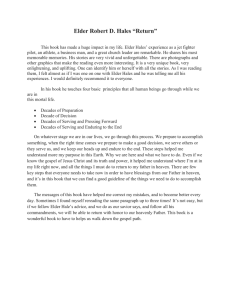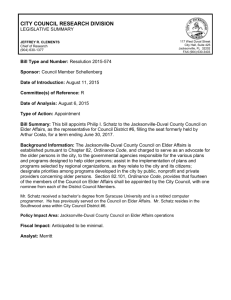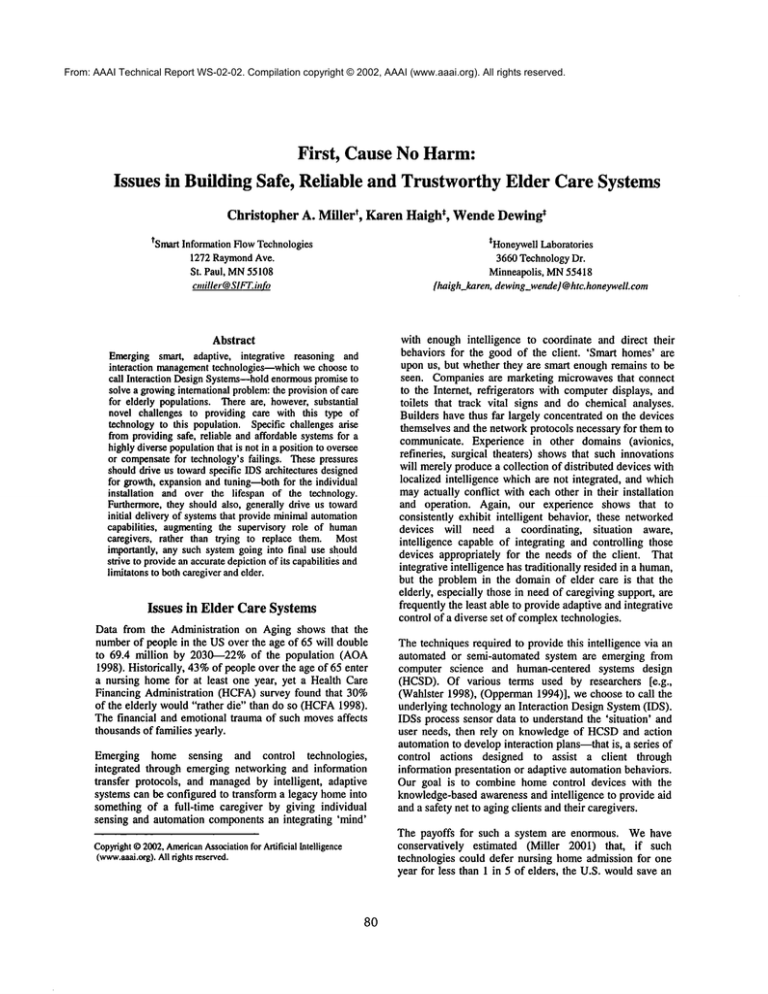
From: AAAI Technical Report WS-02-02. Compilation copyright © 2002, AAAI (www.aaai.org). All rights reserved.
First, Cause No Harm:
Issues in Building Safe, Reliable and Trustworthy Elder Care Systems
Christopher A. Miller t, KarenHaigh*, WendeDewing*
tSmart InformationFlowTechnologies
1272 RaymondAve.
St. Paul, MN55108
cmil ler@SIFEinfo
¢HoneywellLaboratories
3660TechnologyDr.
Minneapolis, MN55418
[haigh_karen, dewing_wende}@htc.honeywell.com
Abstract
Emergingsmart, adaptive, integrative reasoning and
interaction management
technologies---whichwe chooseto
call Interaction DesignSystems---holdenormouspromiseto
solve a growinginternational problem:the provisionof care
for elderly populations. Thereare, however,substantial
novel challenges to providing care with this type of
technologyto this population. Specific challenges arise
from providingsafe, reliable andaffordable systemsfor a
highlydiversepopulationthat is not in a positionto oversee
or compensatefor technology’s failings. These pressures
shoulddrive us towardspecific IDSarchitectures designed
for growth,expansionandtuning---both for the individual
installation and over the lifespan of the technology.
Furthermore,they should also, generally drive us toward
initial delivery of systemsthat provideminimalautomation
capabilities, augmentingthe supervisory role of human
caregivers, rather than trying to replace them. Most
importantly, any such systemgoing into final use should
strive to providean accuratedepictionof its capabilities and
limitatonsto bothcarogiverandelder.
Issues in Elder Care Systems
Data from the Administration on Aging shows that the
numberof people in the USover the age of 65 will double
to 69.4 million by 2030--22% of the population (AOA
1998). Historically, 43%of people over the age of 65 enter
a nursing homefor at least one year, yet a Health Care
Financing Administration (HCFA)survey found that 30%
of the elderly would "rather die" than do so (HCFA1998).
The financial and emotional trauma of such movesaffects
thousandsof families yearly.
Emerging home sensing and control technologies,
integrated through emerging networking and information
transfer protocols, and managedby intelligent, adaptive
systems can be configured to transform a legacy homeinto
something of a full-time caregiver by giving individual
sensing and automation componentsan integrating ’mind’
with enough intelligence to coordinate and direct their
behaviors for the good of the client. ’Smart homes’ are
upon us, but whether they are smart enough remains to be
seen. Companies are marketing microwaves that connect
to the Internet, refrigerators with computerdisplays, and
toilets that track vital signs and do chemical analyses.
Builders have thus far largely concentrated on the devices
themselves and the network protocols necessary for them to
communicate. Experience in other domains (avionics,
refineries, surgical theaters) shows that such innovations
will merelyproduce a collection of distributed devices with
localized intelligence which are not integrated, and which
mayactually conflict with each other in their installation
and operation. Again, our experience shows that to
consistently exhibit intelligent behavior, these networked
devices will need a coordinating, situation aware,
intelligence capable of integrating and controlling those
devices appropriately for the needs of the client. That
integrative intelligence has traditionally resided in a human,
but the problem in the domain of elder care is that the
elderly, especially those in need of caregiving support, are
frequently the least able to provide adaptive and integrative
control of a diverse set of complextechnologies.
The techniques required to provide this intelligence via an
automated or semi-automated system are emerging from
computer science and human-centered systems design
(HCSD). Of various terms used by researchers [e.g.,
(Wahlster 1998), (Opperman1994)], we choose to call
underlying technology an Interaction Design System (IDS).
IDSs process sensor data to understand the ’situation’ and
user needs, then rely on knowledge of HCSDand action
automationto developinteraction plans--that is, a series of
control actions designed to assist a client through
information presentation or adaptive automation behaviors.
Our goal is to combine home control devices with the
knowledge-basedawareness and intelligence to provide aid
and a safety net to agingclients and their caregivers.
The payoffs for such a system are enormous. Wehave
conservatively estimated (Miller 2001) that, if such
technologies could defer nursing homeadmission for one
year for less than 1 in 5 of elders, the U.S. wouldsave an
Copyright
©2002,American
Association
for ArtificialIntelligence
(www.aaai.org).
Allrights reserved.
80
estimated $22 billion in 2005 alone--not to mention untold
familial suffering.
Addressing
But the barriers to such systems are also enormous.
Technologically, we know or are developing multiple
methodsfor fielding IDSs, but the moresignificant barriers
are likely to be ones of user acceptance, systemreliability,
cost effective fielding and adaptation to the wide range of
user and homecharacteristics that such systems must cover.
And, of course, safety and quality of life should take
precedence over technology for technology’s sake in this
domain even more than others. The unique challenges
involved in developingour vision of such a systeminclude:
Interpreting and handling the needs of a population
with varying capabilities and constraints, acting in
unconstrained, unstructured environments. Clients
will differ widely in cognitive, sensory, and mobility
capabilities; moreovertheir capabilities can change,
sometimesslowly over time, sometimesabruptly.
Designing interfaces and interactions that will be
usable and accepted by a potentially technophabic
generation with divergent capabilities. Even though
being able to live at homeis a strong motivator, we
cannot dependon our users to learn about and adapt
to the system.
Designing an affordable system Previous IDS
developments have relied on industry or military
funding. Home-based, elder support systems may
have to rely on individual
homeowners or
caregivers. To realize their full social and economic
benefits, such systems must leverage existing
structures and appliances of older, possibly
antiquated
homes. This challenge requires
developing unique reasoning components that can
analyze situations based on the inputs of a variety of
low cost, off-the-shelf sensors---not expensive,
specialized hardware. Furthermore, the developed
system must enable an inexpensive, easy, and quick
installation of hardware, software and knowledgebased components, and also must include methods
for ongoing adaptation of those componentsto the
changingneeds and situations of the client.
These problems will be explored below in the context of
achieving two critical attributes for IDS systems. Wewill
present thoughts about how IDS approaches, and IDS
implementation programs, can overcome them. In most
cases, this trio of challenges listed above demands a
solution, at least in the near term, which is not at the
highest end of IDStechnological feasibility, but rather uses
a small amount of IDS technology to create or increase
safety, accuracy and usability in a reliable and cost
effective system.
81
the Issues
Accuracy in Situation-Response
Reasoning
Traditional automation (especially home automation)
operates using very simple situation-response patterns. If
the temperature in the house is above a setpoint, the
thermostat turns off the furnace. This simplicity proves
effective because it is reliable, and because it makesuse of
humanoversight to ensure that what the automation does is
appropriate in context--e.g., to determine whether the
setpoint is correct and the furnace is functioning.
A caregiving IDS provides benefit to the elderly by taking
on (or sharing) muchof the responsibility for reasoning
about what is appropriate in context. To fully and
accurately take on this responsibility meansthat (1) the
system must have vastly more, and more complicated,
situation-response patterns than traditional automation, (2)
those patterns must take muchmore into account, and (3)
responses need to be coordinated over many possible
devices.
A critical risk for a care giving IDS is that it will be
inaccurate or imprecise in detecting situations of interest,
because of faulty or insufficient sensor data, bad links
betweensensor data and situations, and/or an incomplete or
erroneous set of defined situations.
The problem of
accurate situation assessment has plagued prior IDSs. For
example, most users of Microsoft WordTM 95 or 97 have
had the experience of the Office Assistant offering help
with drafting a letter when what they wanted to do was
somethingcompletely different.
The risk of inaccurate situation assessment is exacerbated
by several factors: first, a ’situation of interest’ will differ
from client to client and household to household. Second,
available sensors will also likely differ in each home.
Third, the numberof options available to a person moving
about his/her home is likely far greater (and thus,
predictability will be far lower) than a pilot following
mission plan. If, due to any of these barriers, the system
cannot deliver accurate and reliable assessment of a
sufficient numberof critical situations, then all of its ability
to customizeinteraction responses will be in vain.
Similarly, the risk of inaccurate response generation is also
present though, perhaps, under more control by the
designer. Factors that exacerbate this probleminclude the
sheer diversity of the user population combinedwith the
fact that manyelderly users will be less able--physically,
cognitively and perhaps even emotionally---to adjust to
sub-optimal system responses than the general population
might be. Similarly, at least some elders will find it
difficult to control or modify a complicated computerbased system----or to go through lengthy set up procedures.
determining or predicting usability for IDS systems in its
infancy (Miller 2000), but the science of providing usable
human-computerinteractions for elderly or special-needs
clients is also far from perfect. Previous experiencein other
domains has shown user discomfort with feeling ’out of
control’ or ’watched and supervised.’ Wehave also noted
the extreme visibility
of a single error compared to
hundreds of ’correct’ actions. Weexpect users’ acceptance
issues with an elder care system will stem from concerns
about reliance on technology to perform functions
previously carded out by a person, a product look-and-feel
that is incompatible with the users’ homeenvironment, and
a human-systeminteraction that is perceived to be too
computer-like.
But note that there is a trade.off betweenthe amountand
sophistication of automated aiding which is provided (in
terms of the complexity of system reasoning), the degree of
’coverage’ of situationally
appropriate reasoning,
integration and responding which the system must perform
and the role of humans in ensuring correct behavior in
context. To the degree that humanscan be put in the role
of providing oversight and ensuring that lower level system
reasoning and behaviors are appropriate for the contexts in
whichthey occur, the burden on the system to provide this
is diminished. The thermostat described above is an
extreme form of choosing substantial humanresponsibility
and low levels of system automation and integration. At
the other end of the spectrum are some visions of smart
(one might even say ’brilliant’) homesthat knowvirtually
everything about their clients and how to adapt to meet
their needs. Intermediate positions are possible, and will
likely make more sense for elder support systems in the
These risks can be mitigated by employing a user-centered
development process that devotes substantial program
effort to both initial knowledgeacquisition and subsequent
usability testing. HCSD
is a design philosophythat defines
humanusers as integral componentsof any human-machine
system. The goal of HCSDis to develop systems that
behave in ways that match users’ expectations and are
sensitive to their physical, psychological, and cognitive
abilities.
near tenn.
For example, instead of trying to create a system that
knowswhento call emergencyservices for an elderly client
who has had a heart attack, it may make more sense to
create a system that knowsto alert a formal or informal
caregiver about a lack of client mobility. Here, we’ve
traded a portion of system autonomy and incurred more
humanworkload, but we have reduced the requirements for
systemaccuracyand reliability. If the goal is to reduce the
load on a caregiver, rather than to replace himor her, the
latter approach may be both thoroughly acceptable and, in
fact, morenearly feasible with existing technology.
The application of advanced technology to the homedoes
not inherently provide ease-of-use. It does provide
increased design flexibility,
which in turn creates an
opportunity for optimal system performance. In a domain
as diverse as eider care, it will be necessary to In’st
establish the range of users and situations of interest. In our
work, we have done this initially
through review of
documentation (e.g., AARPstudies), consultant experts,
observation, interviews and ’ride alongs’ with caregivers
and technical installers. Similarly, when investigating
human interaction with the caregiving system, we have
selected representative scenarios to inspect the range of
possible situations, users, devices, etc. and have observed
user interactions in naturalistic andlab settings.
A final point to be madeabout the abovetradeoff is that the
worst possible arrangement may be when the system is
built (or sold) to take more of the responsibility for
providing correct behavior in context than it can reliably
provide. The result of such an arrangement will be a
situation that needs somesort of aiding, a machinesystem
that is falling to provide correct aiding, a caregiver whois
relying on the aid and, therefore, not detecting and address
the problem on his or her own, and an elder who is less
than fully capable of either addressing the problem or of
calling for help.
The attempt to apply IDS technology to the elder care
domain poses new usability and usability evaluation
challenges as well. The traditional techniques used for
HCSDwill require innovative adaptation for IDS design.
Muchprevious work in creating IDS systems has been
morefocused on achieving intelligent behaviors rather than
usable ones. We must not make that mistake if the
caregiving systemis to be usable and reliable by its target
community.It is difficult to test a highly advancedsystem
before it is built. It is also essentially impossibleto test all
of the behaviors a caretaking IDS could provide.
Traditional focus group and user questionnaire problems
will be even moreaffected by the potential inability for this
user group to envision the range of possible functions and
interactions a caregiving IDS could provide--much less to
fully understand how it would affect their daily lives.
Instead, a range of part-task evaluations and Wizardof Oz
(human emulation of system behavior) techniques should
Overall System Usability
While IDS systems are currently reaching reality, system
TM
usability remains a paramount issue. The Microsoft
Paperclip has been less that completely successful arguably
because it did not use the IDScapabilities it possessedin a
user acceptable fashion. User acceptance levels of our work
on an IDS system for military rotoreraft were noteworthy
not because they were extraordinarily high (C. Miller 2000)
but precisely because they were beginning to indicate
feasibility in a real worldsetting.
The usability challenges facing elder care systems are
particularly
daunting. Not only is the ’science’ of
82
be given substantial weight to achieve HCSD
inputs early
and often. Another solution is to be sure to create the
system so as to support a wide range of interaction and
interface behaviors.
Whether all such behavioral
alternatives need to be designed concurrently, or provided
to end users as tuning features, is a separate question whose
answer maywell be "no’. Wenote that there maywell be a
substantial role for machine learning to tune system
behaviors to the wide variety of users and user situations.
Regardless of howthe tuning is achieved, it must be; small
differences in the ’face’ that an IDSsystem presents to its
users can make huge differences in user acceptance.
Fortunately, manyIDS architectures inherently support or
at least facilitate the ability to tune interactions to different
users and situations.
Some Design
conclusion, and it maybe acceptable to report this
probability (though the utility of that is yet to be
determined). It would, however, be unacceptable
and potentially misleading and dangerousto report
that the elder had gotten up on the basis of that
observation alone.
Goals
In this section, we boil downthe discussion above into a
few design principles or goals that we feel should be sought
in the design of IDSsfor elder care. These are heuristics,
at best, and they will not be equally applicable to all cases
and designs, nor will their manifestation be the samein all
contexts, but we feel that they are generally goodadvice for
those attempting to field an automated caregiving system
that will provide benefit in this domain.
1.
Cause no harm. Designing technology to
substitute for a human caregiver in the home
environment is substantially
different than
designing other aiding, support or entertainment
systems and appliances for the home. We are
likely removing traditional
human support
networks and, thus, we must ensure that they are
fully and completely replaced by technology. The
burden of proof should be on the new system to
showthat any modification it causes will enhance,
or at least not diminish, safety for the elder.
Quality of life enhancementsare desirable, but
they are secondaryto safety considerations.
2.
Accurately convey system capabilities,
data,
assumptions and limitations. Forces will combine
to tempt system designers (and marketers)
claim more for their systems than the systems can
provide. All the traditional factors of marketing
will push toward this end, but a more insidious
pressure will be present as well. Users of such
support systems will need and want information at
a higher level than the system maybe fully able to
provide, and the temptation will be to give it to
them. For example, a remote caregiver may want
to know whether the elder has gotten up this
morning. By contrast, the implemented system
may only be able to report that motion was
detected in the kitchen at 9:03 AM.There is a
probabilistic link betweenthe observation and the
83
3.
Avoid depending on the elderly client for active
input of information either at configuration or on
an ongoing basis. This constraint can be relaxed
for someapplications, but in general requiring the
elder to actively participate
in providing
information to the system should be avoided. Not
only is this intrusive, it is also unreliable and may
fall precisely when it is needed most--when the
elder is most in needof help.
4.
Don’t prohibit the elderly client from providing
active input. While active input from the elder
should not be relied upon, especially for safety
critical functions, the elder should be capable of
adapting and configuring the systemto better suite
his or her needs. To prohibit this wouldadd to the
feeling of being watched and controlled by
automation and would, again, lead to lack of user
acceptance.
5.
Design for growth. The consequences of many of
our other principles
may well be a certain
conservativism in the fielding of technology to
provide care to the elders. Sometechnologies will
not yet meet the safety, reliability, and accuracy
tests required to cause no harm and provide
accurate information that is also useful. But these
technologies will mature as time passes and there
will be pressure to incorporate them into the
caregiving environment. A system that is capable
of incorporating new and enhanced technologies
into its general environment will be superior to
one that must be scrapped. This applies especially
to the system interfaces
which the elder
experiences
and to the elder’s
physical
environment---being able to add a new system
capability without requiring the eider to learn a
newset of UI actions or ripping out walls to install
newwiring will be an enormousadvantage.
6.
Design for change. The previous principle
emphasized the growth of technology. It is also
characteristic of this domain that the elder’s
capabilities will change. These changeswill drive
the need for modifying, and frequently growing,
the capabilities of the system over time. This will
be true both on large time scales (e.g., during the
progression of Alzheimer’s) and on small ones
(e.g., the elder has the flu today and won’t be
getting up as much). System reasoning and
response behaviors must be sensitive to both kinds
of change.
7.
8.
themselves. Caregiving technology, like caregiving itself,
should first strive to do no harm.
Design for variance. The degree of variance
among potential users and usage contexts for
caregiving technology systems is dramatic. In
other domains for which safety critical systems
have been designed (e.g., aviation, military
systems, industrial processing, power generation,
medicine) users are frequently selected for
certain common
set of skills and then trained to
behave in common ways.
Operational
environments, such as a surgical theater or
cockpit, are designed specifically for the tasks to
be performed there and to have specific
commonalitieswith all other cockpits or theaters.
None of this is true for the elder care domain.
Elders have a wide variety of capabilities,
personalities, education, experience, etc. and their
homes and their contents will vary enormously.
While it will be acceptable (and maybenecessary)
to select more nearly homogenousgroups for the
fielding of specific systems, it is quite likely that
every caregiving
system will need to be
configured and adapted to the specific user and
homeit encounters. Not only must this range of
adaptation be designed into the system, but
methods for accomplishing it in an easy and cost
effective mannerwill likely make the difference
betweena successful aid and a failure.
Acknowledgements
This work was jointly funded by Honeywell and a NIST
Advanced Technology Program. Our thanks to Stephen
Whitlow, Dave Tomsand Bob Owenfor help in the initial
generation of these thoughts.
References
AOA(1998). Profile of Older Americans, Administration
on Aging. http://www.aoa.gov.
C. Miller, M. H., S. Guerlain . (2000). "The Rotorcraft
Pilot’s Associate: design and evaluation of an intelligent
user interface for cockpit information management."
KnowledgeBased Systems, 12: 443-456.
HCFA(1998). Health Care Financing Administration.
http:llwww.hcfa.gov/statslnhe-proil
Miller, C. (2000). Rules of Etiquette, or how a mannerly
AUIshould comportitself to gain social acceptance and be
perceived as gracious and well-behaved in polite society.
Proceedings of the AAAI Spring Symposium on Adaptive
User Interfaces, Stanford, CA.
Designto enhancequality of life. Elders can face
several emotionally and mentally stressful losses
as they age---the loss of freedom, privacy and
convenienceassociated with impersonal, inept and
unhelpful technology need not be one of them.
Weshould continually seek ways to make the
impact of technology as caregiver be a positive
one for the elders that must experience it. After
safety and accuracy concerns are addressed, the
next question that should be asked about a
prospective aiding technology is "will this make
life better for the elderly client?"
Miller, C. (2001). Automation as Caregiver; The Role
AdvancedTechnologies in ElderCare. Proceedings of the
HumanFactors and Ergonomics Society Annual Meeting,
Minneapolis, MN;October 8-12.
Opperman,R. (1994). Adaptive User Support. Hillsdale,
N J, LawrenceErlbaum.
Maybury, M. and Wahlster, W. (1998). Intelligent
Interfaces. San Francisco, CA., MorganKaufman.
Conclusions
Fielding an IDS system for elder caregiving support should
be regarded as a long term project which begins with
simple functions for a select and restricted user community
and which offload humancaregivers slightly but in no way
removethem from the loop. As these simple behaviors are
tuned and proven to be acceptable, reliable and safe-thanks to the flexibility inherent in IDS technology--we
can begin to expandsystem functionality and to broker the
system into new user communities. To proceed in any
other fashion would not only jeopardize the acceptance of
IDS technology in this domain, but it would also risk the
lives and health of some who are least able to fend for
84
User


